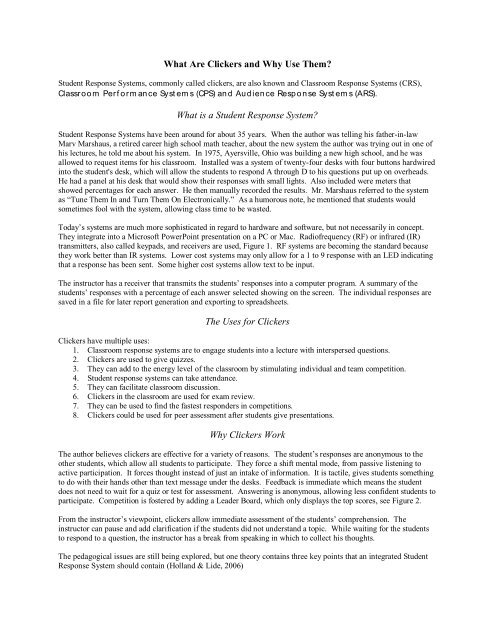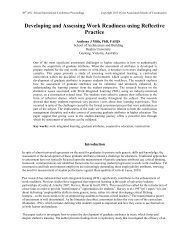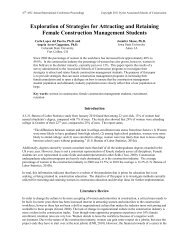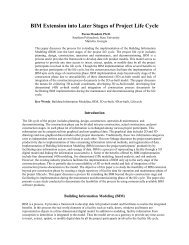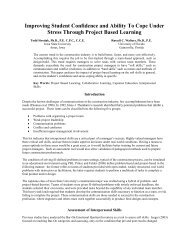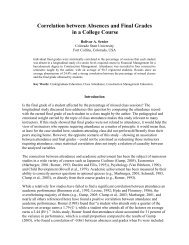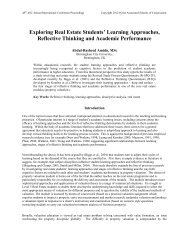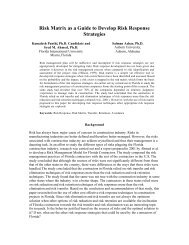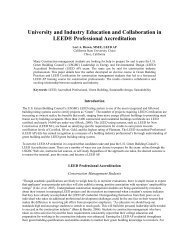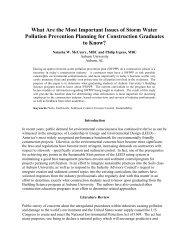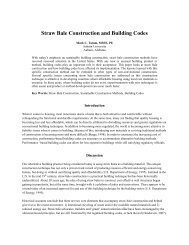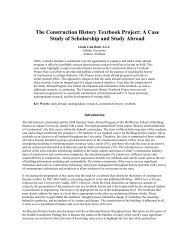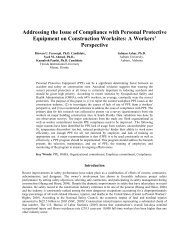Using Clickers in the Construction Classroom
Using Clickers in the Construction Classroom
Using Clickers in the Construction Classroom
Create successful ePaper yourself
Turn your PDF publications into a flip-book with our unique Google optimized e-Paper software.
What Are <strong>Clickers</strong> and Why Use Them<br />
Student Response Systems, commonly called clickers, are also known and <strong>Classroom</strong> Response Systems (CRS),<br />
Classroo m Perf o rm an ce Syst em s (CPS) an d Aud ien ce Resp o n se Syst em s (ARS).<br />
What is a Student Response System<br />
Student Response Systems have been around for about 35 years. When <strong>the</strong> author was tell<strong>in</strong>g his fa<strong>the</strong>r-<strong>in</strong>-law<br />
Marv Marshaus, a retired career high school math teacher, about <strong>the</strong> new system <strong>the</strong> author was try<strong>in</strong>g out <strong>in</strong> one of<br />
his lectures, he told me about his system. In 1975, Ayersville, Ohio was build<strong>in</strong>g a new high school, and he was<br />
allowed to request items for his classroom. Installed was a system of twenty-four desks with four buttons hardwired<br />
<strong>in</strong>to <strong>the</strong> student's desk, which will allow <strong>the</strong> students to respond A through D to his questions put up on overheads.<br />
He had a panel at his desk that would show <strong>the</strong>ir responses with small lights. Also <strong>in</strong>cluded were meters that<br />
showed percentages for each answer. He <strong>the</strong>n manually recorded <strong>the</strong> results. Mr. Marshaus referred to <strong>the</strong> system<br />
as “Tune Them In and Turn Them On Electronically.” As a humorous note, he mentioned that students would<br />
sometimes fool with <strong>the</strong> system, allow<strong>in</strong>g class time to be wasted.<br />
Today’s systems are much more sophisticated <strong>in</strong> regard to hardware and software, but not necessarily <strong>in</strong> concept.<br />
They <strong>in</strong>tegrate <strong>in</strong>to a Microsoft PowerPo<strong>in</strong>t presentation on a PC or Mac. Radiofrequency (RF) or <strong>in</strong>frared (IR)<br />
transmitters, also called keypads, and receivers are used, Figure 1. RF systems are becom<strong>in</strong>g <strong>the</strong> standard because<br />
<strong>the</strong>y work better than IR systems. Lower cost systems may only allow for a 1 to 9 response with an LED <strong>in</strong>dicat<strong>in</strong>g<br />
that a response has been sent. Some higher cost systems allow text to be <strong>in</strong>put.<br />
The <strong>in</strong>structor has a receiver that transmits <strong>the</strong> students’ responses <strong>in</strong>to a computer program. A summary of <strong>the</strong><br />
students’ responses with a percentage of each answer selected show<strong>in</strong>g on <strong>the</strong> screen. The <strong>in</strong>dividual responses are<br />
saved <strong>in</strong> a file for later report generation and export<strong>in</strong>g to spreadsheets.<br />
The Uses for <strong>Clickers</strong><br />
<strong>Clickers</strong> have multiple uses:<br />
1. <strong>Classroom</strong> response systems are to engage students <strong>in</strong>to a lecture with <strong>in</strong>terspersed questions.<br />
2. <strong>Clickers</strong> are used to give quizzes.<br />
3. They can add to <strong>the</strong> energy level of <strong>the</strong> classroom by stimulat<strong>in</strong>g <strong>in</strong>dividual and team competition.<br />
4. Student response systems can take attendance.<br />
5. They can facilitate classroom discussion.<br />
6. <strong>Clickers</strong> <strong>in</strong> <strong>the</strong> classroom are used for exam review.<br />
7. They can be used to f<strong>in</strong>d <strong>the</strong> fastest responders <strong>in</strong> competitions.<br />
8. <strong>Clickers</strong> could be used for peer assessment after students give presentations.<br />
Why <strong>Clickers</strong> Work<br />
The author believes clickers are effective for a variety of reasons. The student’s responses are anonymous to <strong>the</strong><br />
o<strong>the</strong>r students, which allow all students to participate. They force a shift mental mode, from passive listen<strong>in</strong>g to<br />
active participation. It forces thought <strong>in</strong>stead of just an <strong>in</strong>take of <strong>in</strong>formation. It is tactile, gives students someth<strong>in</strong>g<br />
to do with <strong>the</strong>ir hands o<strong>the</strong>r than text message under <strong>the</strong> desks. Feedback is immediate which means <strong>the</strong> student<br />
does not need to wait for a quiz or test for assessment. Answer<strong>in</strong>g is anonymous, allow<strong>in</strong>g less confident students to<br />
participate. Competition is fostered by add<strong>in</strong>g a Leader Board, which only displays <strong>the</strong> top scores, see Figure 2.<br />
From <strong>the</strong> <strong>in</strong>structor’s viewpo<strong>in</strong>t, clickers allow immediate assessment of <strong>the</strong> students’ comprehension. The<br />
<strong>in</strong>structor can pause and add clarification if <strong>the</strong> students did not understand a topic. While wait<strong>in</strong>g for <strong>the</strong> students<br />
to respond to a question, <strong>the</strong> <strong>in</strong>structor has a break from speak<strong>in</strong>g <strong>in</strong> which to collect his thoughts.<br />
The pedagogical issues are still be<strong>in</strong>g explored, but one <strong>the</strong>ory conta<strong>in</strong>s three key po<strong>in</strong>ts that an <strong>in</strong>tegrated Student<br />
Response System should conta<strong>in</strong> (Holland & Lide, 2006)


